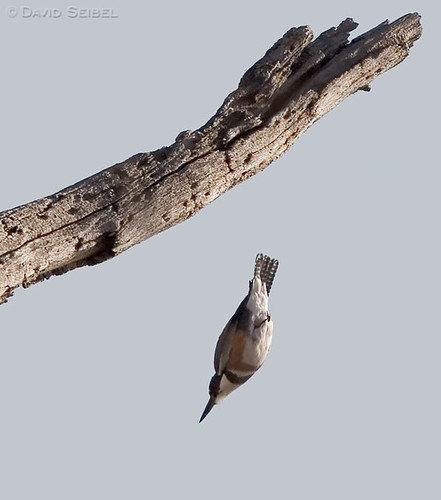
Taking the Plunge
(Female Belted Kingfisher, Ceryle alcyon).
Image appears here with the kind permission of the photographer, David Seibel, who writes;
"I never realized, until freezing the motion with my camera, that kingfishers dive from
their perch with wings completely folded. I've captured woodpeckers doing the same
thing." [email David]
Birds in Science
A biologist studying wild songbirds in New York State reported that all 178 woodland birds he tested last year had unusually high levels of mercury in their blood and feathers, a sign that the toxic chemical has spread farther in the environment than previously thought. The biologist, David Evers, who is also executive director of the Biodiversity Research Institute, a nonprofit ecological organization in Gorham, Maine, said his preliminary findings challenged existing perceptions about how far mercury travels, how it interacts with the environment and how it affects various forms of wildlife -- all with worrisome implications for people. While mercury has often been found in lakes and streams and in fish, Dr. Evers's work documents the unexpected presence of the chemical in birds that do not live on water and never eat fish.
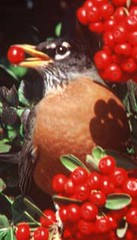 Regions responsible for singing and mating in the brains of American robins, Turdus migratorius (pictured), shrink when exposed to high levels of DDT, says new University of Alberta research -- the first proof that natural exposure to a contaminant damages the brain of a wild animal. "These residues have been persisting since the late 1960s -- that's what is really disturbing," said Dr. Andrew Iwaniuk, a post-doctoral research fellow in the Department of Psychology. "It has been years since it has been used and still has this effect." The new research, published in Behavioural Brain Research, strongly suggests that exposure to environmental levels of DDT causes significant changes in the brains of songbirds. [Image: Mathew Tekulsky, National Geographic].
Regions responsible for singing and mating in the brains of American robins, Turdus migratorius (pictured), shrink when exposed to high levels of DDT, says new University of Alberta research -- the first proof that natural exposure to a contaminant damages the brain of a wild animal. "These residues have been persisting since the late 1960s -- that's what is really disturbing," said Dr. Andrew Iwaniuk, a post-doctoral research fellow in the Department of Psychology. "It has been years since it has been used and still has this effect." The new research, published in Behavioural Brain Research, strongly suggests that exposure to environmental levels of DDT causes significant changes in the brains of songbirds. [Image: Mathew Tekulsky, National Geographic].
People Helping Birds
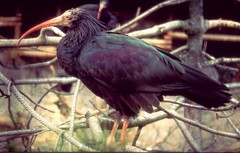 Three members of a bird species thought to be extinct in the Middle East until four years ago have been satellite tagged to aid conservation efforts. Scientists will track the migration of the birds as they leave their breeding sites near Palmyra in south-east Syria. The northern bald ibis, Geronticus eremita (pictured), was revered by the Egyptian Pharaohs and was once widespread across the Middle East, northern Africa and the European Alps. There are now only 13 left in Syria and 100 breeding pairs in Morocco. Ibrahim Khader, head of BirdLife Middle East, said re-discovering the ibis was like finding the Arabian phoenix. "We knew they were in Palmyra because of reports from Bedouin nomads and local hunters. Without this tracking project, the bird would have been consigned to history and hieroglyphics." [Image: Alpenzoo, 2002].
Three members of a bird species thought to be extinct in the Middle East until four years ago have been satellite tagged to aid conservation efforts. Scientists will track the migration of the birds as they leave their breeding sites near Palmyra in south-east Syria. The northern bald ibis, Geronticus eremita (pictured), was revered by the Egyptian Pharaohs and was once widespread across the Middle East, northern Africa and the European Alps. There are now only 13 left in Syria and 100 breeding pairs in Morocco. Ibrahim Khader, head of BirdLife Middle East, said re-discovering the ibis was like finding the Arabian phoenix. "We knew they were in Palmyra because of reports from Bedouin nomads and local hunters. Without this tracking project, the bird would have been consigned to history and hieroglyphics." [Image: Alpenzoo, 2002].
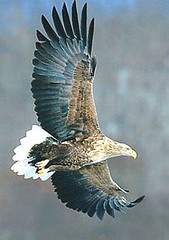 A white-tailed sea eagle chick, Haliaeetus albicilla (subadult pictured), on the Skye in Scotland has become the 200th to take to the air since the birds began breeding again in Scotland 21 years ago. Skye is home to a quarter of Scotland's white-tailed eagle population and RSPB Scotland said it is one of the best places to see the birds in their natural habitat. Alison MacLennan, the society's Skye officer, said the 200th fledgling marked a milestone for the program. "Perhaps what is most impressive is that it took us 31 years from the first introduced birds to see a hundred wild-fledged sea eagles - and just the last six years for that figure to double," said MacLennan. [Image: Iran Daily].
A white-tailed sea eagle chick, Haliaeetus albicilla (subadult pictured), on the Skye in Scotland has become the 200th to take to the air since the birds began breeding again in Scotland 21 years ago. Skye is home to a quarter of Scotland's white-tailed eagle population and RSPB Scotland said it is one of the best places to see the birds in their natural habitat. Alison MacLennan, the society's Skye officer, said the 200th fledgling marked a milestone for the program. "Perhaps what is most impressive is that it took us 31 years from the first introduced birds to see a hundred wild-fledged sea eagles - and just the last six years for that figure to double," said MacLennan. [Image: Iran Daily].
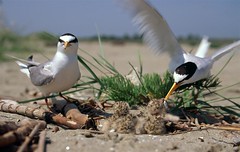 Round-the-clock protection of rare sea birds in the UK, the little tern, Sterna albifrons(pictured with chicks), by RSPB volunteers and wardens has paid off with the successful fledging of about 370 chicks in the past few days. Several hundred more are expected to fledge this week from the record count of 369 nests this year - believed to be the biggest colony in Europe. In recent years, the little terns have suffered a series of setbacks due to predation, vandalism, disturbance and problems with food supply. [Image: WWF]
Round-the-clock protection of rare sea birds in the UK, the little tern, Sterna albifrons(pictured with chicks), by RSPB volunteers and wardens has paid off with the successful fledging of about 370 chicks in the past few days. Several hundred more are expected to fledge this week from the record count of 369 nests this year - believed to be the biggest colony in Europe. In recent years, the little terns have suffered a series of setbacks due to predation, vandalism, disturbance and problems with food supply. [Image: WWF]
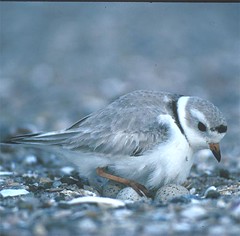 Two hundred disappointed riders and drivers of all-terrain vehicles will have to find another place to hold their New Brunswick's Miscou Island beach rally, thanks to Ian L'Anglais. ATV riders have been holding their annual rally on the picturesque beach for 15 years, tearing up and down the shore at low tide, having a whale of a time. They were going to do it again this weekend. "Seeing that these beaches have a number of piping plover nests, we decided that we had to step in and make sure that the population doesn't keep declining," said L'Anglais, an enforcement coordinator with the species-at-risk branch of Environment Canada. There are only 5,913 adults piping plovers, Charadrius melodus (pictured on nest), in the world, and 422 of them are in Atlantic Canada. New Brunswick has more than any other province on the Atlantic. Even so, there were only 203 adults in New Brunswick in 1991 and even fewer, 146, in 1996. [Image: USFWS]
Two hundred disappointed riders and drivers of all-terrain vehicles will have to find another place to hold their New Brunswick's Miscou Island beach rally, thanks to Ian L'Anglais. ATV riders have been holding their annual rally on the picturesque beach for 15 years, tearing up and down the shore at low tide, having a whale of a time. They were going to do it again this weekend. "Seeing that these beaches have a number of piping plover nests, we decided that we had to step in and make sure that the population doesn't keep declining," said L'Anglais, an enforcement coordinator with the species-at-risk branch of Environment Canada. There are only 5,913 adults piping plovers, Charadrius melodus (pictured on nest), in the world, and 422 of them are in Atlantic Canada. New Brunswick has more than any other province on the Atlantic. Even so, there were only 203 adults in New Brunswick in 1991 and even fewer, 146, in 1996. [Image: USFWS]
Conservation groups say new guidelines will help keep sage grouse, Centrocercus sp., protected and off the endangered species list, benefiting not only the animals, but also industry. Biologists maintain that sage grouse populations have declined 93 percent from historic levels, due primarily to human development. Now, 70 percent of sage grouse habitat is on public land, much of which is either developed or earmarked for development by the oil and gas industry. In January of 2005, the U.S. Fish and Wildlife Service denied three petitions to list the sage grouse under the Endangered Species Act, saying "sage grouse are not likely to become endangered or threatened in the foreseeable future." Fish and Wildlife did, however, agree that mining and energy development, predation, urbanization, and wildfire threaten sage grouse populations and sagebrush habitat.
Birds and Wind Farms
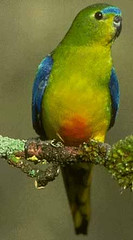 The orange-bellied parrot, Neophema chrysogaster (pictured) -- a frequent flyer to the Limestone Coast of South Australia -- has just been nominated for inclusion on the Commonwealth's list of critically endangered fauna. Inclusion could halt further developments by the region's wind farm industry. Only 150 individuals are estimated to be alive today, and the South Australian and Victorian governments have already listed the bird as being critically endangered. But at the federal level, it is just an endangered animal. Chris Tzaros, orange-bellied parrot project officer with Birds Australia, says his organization is supportive of wind farms, but only where they do not threaten birds like the orange-bellied parrot. The bird is peculiar in the parrot family because the entire population migrates. Every March, the orange-bellied parrot flies from its breeding grounds in southern Tasmania to the coast between south Gippsland and the Murray Mouth, returning in October. [Image: ZPGB's Conservation & Research Department, Australia].
The orange-bellied parrot, Neophema chrysogaster (pictured) -- a frequent flyer to the Limestone Coast of South Australia -- has just been nominated for inclusion on the Commonwealth's list of critically endangered fauna. Inclusion could halt further developments by the region's wind farm industry. Only 150 individuals are estimated to be alive today, and the South Australian and Victorian governments have already listed the bird as being critically endangered. But at the federal level, it is just an endangered animal. Chris Tzaros, orange-bellied parrot project officer with Birds Australia, says his organization is supportive of wind farms, but only where they do not threaten birds like the orange-bellied parrot. The bird is peculiar in the parrot family because the entire population migrates. Every March, the orange-bellied parrot flies from its breeding grounds in southern Tasmania to the coast between south Gippsland and the Murray Mouth, returning in October. [Image: ZPGB's Conservation & Research Department, Australia].
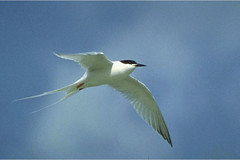 Researchers at Massachusetts Maritime Academy are studying how the school's new 241-foot wind turbine is affecting the flight patterns of birds that fly around the windy campus. Since April, marine science professor Lucy Vlietstra and three of her students have been visually counting the number of common terns, Sterna hirundo, and endangered roseate terns, Sterna dougallii (pictured), that fly into a 150-foot zone around the turbine. The researchers have found that more birds fly into the airspace when the turbine is turned off than when its blades are spinning. "We need more time to look at how strong a pattern it is," Dr. Vlietstra said. She said the terns' feeding behavior has not changed, but that they "seem to avoid close proximity" to the turbine when it is moving. [Image: Pat Lynch/USGS].
Researchers at Massachusetts Maritime Academy are studying how the school's new 241-foot wind turbine is affecting the flight patterns of birds that fly around the windy campus. Since April, marine science professor Lucy Vlietstra and three of her students have been visually counting the number of common terns, Sterna hirundo, and endangered roseate terns, Sterna dougallii (pictured), that fly into a 150-foot zone around the turbine. The researchers have found that more birds fly into the airspace when the turbine is turned off than when its blades are spinning. "We need more time to look at how strong a pattern it is," Dr. Vlietstra said. She said the terns' feeding behavior has not changed, but that they "seem to avoid close proximity" to the turbine when it is moving. [Image: Pat Lynch/USGS].
Parrot News
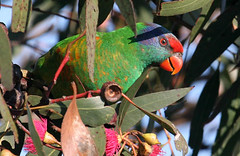 As some of you know, besides pursuing research in parrots and other birds, I live with, and also trained and bred parrots, especially lories (Loriinae) for most of my life. So when a bird pal sends me a link about parrots, especially lories, I cannot resist to add it to the line-up. This photoessay is interesting because it shows the results of lory hybrids resulting when people move wildlife into new areas, thereby removing reproductive barriers that preserved species integrity (to get to this photoessay, first click on "photoessays" and then click on "Lorikeet hybrids"). This slideshow contains images of lories in the population at Leopold on the Bellerine Peninsula, Australia. The birds range from pure Rainbow, Trichoglossus haematodus, and Scaly-breasted Lorikeets, Trichoglossus chlorolepidotus, to Rainbow x Scaly-breasted hybrids, to those with markings that suggest hybrids of all three species in that area (pictured); Rainbow x Scaley-breasted x musk (Glossopsitta concinna) lorikeets. [Image linked from site]
As some of you know, besides pursuing research in parrots and other birds, I live with, and also trained and bred parrots, especially lories (Loriinae) for most of my life. So when a bird pal sends me a link about parrots, especially lories, I cannot resist to add it to the line-up. This photoessay is interesting because it shows the results of lory hybrids resulting when people move wildlife into new areas, thereby removing reproductive barriers that preserved species integrity (to get to this photoessay, first click on "photoessays" and then click on "Lorikeet hybrids"). This slideshow contains images of lories in the population at Leopold on the Bellerine Peninsula, Australia. The birds range from pure Rainbow, Trichoglossus haematodus, and Scaly-breasted Lorikeets, Trichoglossus chlorolepidotus, to Rainbow x Scaly-breasted hybrids, to those with markings that suggest hybrids of all three species in that area (pictured); Rainbow x Scaley-breasted x musk (Glossopsitta concinna) lorikeets. [Image linked from site]
 Would you like to help save a parrot species and get a nice parrot t-shirt that will make all your friends jealous in the process? Well, this is your big chance. Apparently, Jimmy Buffet has a fund-raiser going to help save the endangered Puerto Rican Parrot, Amazona vittata. This fund-raiser will donate $1 from each sale to charity (NOT from each shirt sale, so if you want more than one shirt, buy them separately to make sure that the maximal amount of money is donated to parrot conservation efforts).
Would you like to help save a parrot species and get a nice parrot t-shirt that will make all your friends jealous in the process? Well, this is your big chance. Apparently, Jimmy Buffet has a fund-raiser going to help save the endangered Puerto Rican Parrot, Amazona vittata. This fund-raiser will donate $1 from each sale to charity (NOT from each shirt sale, so if you want more than one shirt, buy them separately to make sure that the maximal amount of money is donated to parrot conservation efforts).
Avian Zoonotic News
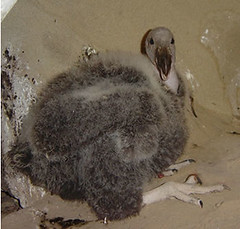 Avian Flu was the main worry of bird owners and sanctuaries earlier this year. But West Nile Virus is killing endangered California condor chicks, Gymnogyps californianus (2.5 month-old chick pictured) at Boise's World Center for Birds of Prey. So far, it's already killed three chicks. And that's a big impact on a small population. Boise's Birds of Prey center produces the most chicks of the nation's breeding centers each year. Out of a current condor population of 300, a hundred came from the World Center for Birds of Prey. Last year, they successfully reared 20 chicks. An outbreak of West Nile was the last thing they expected. [Image: USFWS].
Avian Flu was the main worry of bird owners and sanctuaries earlier this year. But West Nile Virus is killing endangered California condor chicks, Gymnogyps californianus (2.5 month-old chick pictured) at Boise's World Center for Birds of Prey. So far, it's already killed three chicks. And that's a big impact on a small population. Boise's Birds of Prey center produces the most chicks of the nation's breeding centers each year. Out of a current condor population of 300, a hundred came from the World Center for Birds of Prey. Last year, they successfully reared 20 chicks. An outbreak of West Nile was the last thing they expected. [Image: USFWS].
A new vaccine against bird flu, developed by GlaxoSmithKline, is more effective than any previous version and works at a far smaller dose, the company reported yesterday on its Web site. Until now, high dosage requirements have been a major obstacle to making a vaccine for avian flu. An earlier vaccine, made a year ago by Sanofi Pasteur and stockpiled by the government, required such large doses that it would be difficult or impossible to keep up with a pandemic. "The proof of the pudding is, how does it work in the field," said Anthony Fauci, director of the National Institute of Allergy and Infectious Diseases, adding that it would be especially important to find out if the vaccine still worked if the bird flu virus began to change genetically. It is too early, he said, to tell what the government's plans might be for buying and stockpiling this vaccine.
A U.S. duck hunter and two state wildlife employees had evidence of an uncommon type of bird flu virus in their blood, researchers reported Monday in one of the first studies to show that hunters might be at risk. The virus was H11N9, not known to be dangerous to humans and not related to the feared H5N1 virus circulating in wild and domestic birds and among some people, the researchers said. But their study, published in the journal Emerging Infectious Diseases, shows that people who work with wildlife should take care. "To our knowledge, this study is the first to show direct transmission of influenza A viruses from wild birds to humans [italics mine]," James Gill of the University of Iowa and colleagues wrote in their report. GrrlScientist comment: TAKE NOTE OF THE ITALICIZED COMMENT, FAO!
Streaming Birds
 This week on BirdNote, beginning on July 31: Monday, the loquacious Yellow-breasted Chat, Icteria virens; Tuesday, when birds land in parking lots; Wednesday, the begging sounds and postures of baby birds; Thursday, birds that frequent the landfill; and Friday, Hazel Wolf and the Brown Creeper, Certhia americana. BirdNotes transport the listener out of the daily grind with two-minute vignettes that incorporate the rich sounds of birds provided by Cornell University and by other sound recordists, with photographs and written stories that illustrate the interesting -- and in some cases, truly amazing -- abilities of birds. Some of the shows are Pacific Northwest-oriented, but many are of general interest. BirdNote can be heard live, Monday through Friday, 8:58-9:00AM in Western Washington state and Southern British Columbia, Canada, on KPLU radio and now also in North Central Washington state on KOHO radio. All episodes are available in the BirdNote archives, both in written transcript and mp3 formats, along with photographs. Listener ideas and comments are welcomed. [rss].
This week on BirdNote, beginning on July 31: Monday, the loquacious Yellow-breasted Chat, Icteria virens; Tuesday, when birds land in parking lots; Wednesday, the begging sounds and postures of baby birds; Thursday, birds that frequent the landfill; and Friday, Hazel Wolf and the Brown Creeper, Certhia americana. BirdNotes transport the listener out of the daily grind with two-minute vignettes that incorporate the rich sounds of birds provided by Cornell University and by other sound recordists, with photographs and written stories that illustrate the interesting -- and in some cases, truly amazing -- abilities of birds. Some of the shows are Pacific Northwest-oriented, but many are of general interest. BirdNote can be heard live, Monday through Friday, 8:58-9:00AM in Western Washington state and Southern British Columbia, Canada, on KPLU radio and now also in North Central Washington state on KOHO radio. All episodes are available in the BirdNote archives, both in written transcript and mp3 formats, along with photographs. Listener ideas and comments are welcomed. [rss].
There is another podcast/streaming broadcast about birds, On the Wing, is available for July 2006 is available. This month's shows include programs about the Randall Davey Audubon Center in Santa Fe, New Mexico; the Haystack Rock Awareness Program in Cannon Beach, Oregon; the Birding Events Calendar for July 2006; and a look at the Eagle Cam in Kent, Washington, which includes a time-compressed, streaming film of the parent birds and their chicks for you to enjoy. On the Wing takes you where the birds are by reporting on the birds, people and places that make birding one of the fastest-growing outdoor activities. On the Wing features expert-led field trips, interviews with today's newsmakers to upcoming birding events. You can listen to On the Wing programs on the web or download them to your portable audio player. You can also comment on individual programs at the linked index site. [mp3]
Miscellaneous Bird News
Naturalists from Hilton Pond were pleased this week to attend the Native Plant Conference at Western Carolina University, where they presented information about Operation RubyThroat, and native hummer plants. This was the 23rd year for the Cullowhee conference, one of the first and, according to the naturalists at Hilton Pond, still one of the best anywhere that has native flora as its focus. This installment of This Week at Hilton Pond includes a photoessay about native plants and some reasons why exotics have the upper hand in backyard gardens. Included are a tally of birds banded during the previous week, as well as a list of recaptures. There's also a link to a recent cover article in Costa Rica Outdoors that showcases Operation RubyThroat and their 2006 hummingbird banding trip to Guanacaste.
What do bird watching and business have in common? "Bird watching, of all the natural pastimes, is most like business in terms of the cognitive demands pattern recognition requires," according to an article in the November 2002 Harvard Business Review that featured an interview with the author-artist David Sibley and birder Julia Yoshida. "Birders have very little to go on in identifying the birds they see. Most birds, after all, are small, fast-moving creatures, whose survival often depends on their ability to escape detection. Most birders,'' the article continued, "have to learn to see as much as they can in a matter of seconds." I reckoned much the same could be said of hedge fund managers. Read this personal narrative about birding in Central Park, NYC.
Big-box businesses -- Home Depots, Lowe's and even warehouse-style supermarkets, you know the type -- are attracting birds into their stores. Sometimes they're welcome, sometimes not. Home Depot has a catch-and-release policy. But other businesses are finding themselves doing battle with these unwanted visitors, which, because of federal law designed to protect them, sometimes just end up as unwanted residents. But customers, in a lot of cases, don't seem to mind. The birds, after all, are nice to listen to. "The only thing I'd be concerned about are bird droppings, because they can be a health hazard," Pat Sanders said recently while shopping at a Home Depot. "I do like the chirping, but I prefer birds to stay outside."
 Hundreds of people are voicing their opinions about the Idaho state quarter that was unveiled recently. More than 75 percent of people who have voted on the coin on KTVB.COM did not like the design. The Idaho state quarter (pictured) was unveiled at the World Center for Birds of Prey and features a peregrine falcon, the state raptor. But some people were a little confused about what was being depicted. Some thought it was a pigeon, others a hawk or eagle. The new coin will be minted in 2007 and will be available next summer.
Hundreds of people are voicing their opinions about the Idaho state quarter that was unveiled recently. More than 75 percent of people who have voted on the coin on KTVB.COM did not like the design. The Idaho state quarter (pictured) was unveiled at the World Center for Birds of Prey and features a peregrine falcon, the state raptor. But some people were a little confused about what was being depicted. Some thought it was a pigeon, others a hawk or eagle. The new coin will be minted in 2007 and will be available next summer.
This link leads to several photos that were taken of a very rare albino Eastern bluebird fledgling, Sialia sialis, that you might be interested to see.
.
The Fine Print: Thanks to my bird pals who showed me how important Birds in the News is to them by patiently sending bird news story links, despite my unannounced hiatus; Ian, Mary, Diane, Rob, Bruce, Bill, Jeremy, Ellen and Ron for some of the news story links that you are enjoying here. Thanks in advance to Ian for catching my typos; as you probably know by now, I put a few typographical errors in these documents just so Ian can find them! The featured image appears here with the kind permission of the photographer, so please contact him if you also wish to purchase this or other of his images. Other images are resized and are either linked from the news story that they accompany or they are credited and linked back to the photographer.
tags: Birds in the News, ornithology, birds, avian, newsletter
- Log in to post comments


Neat stuff, GrrlScientist. That photo of the diving kingfisher is phenomenal, ranks among the best bird pictures I've ever seen. And the stories under "People Helping Birds" are a much-needed morale boost; it's nice to find that not all the news about endangered wildlife is bad.
I really was missing BitN. Lots of nice stuff. The condor chick is cute.
The thing that always amazes me about wind farms is the caution people show when voicing their opinions. They always put a disclaimer like "[...] his organization is supportive of wind farms, but only where [...]". It's like saying, we are supportive of oil but not when it spills into the ocean. Why all this fear?
The DDT story is disturbing since it has been banned for so long. It is good to have reminders of why it was banned in the first place. I occasionally come across people who think we should bring it back or think that it did little harm.
I was interested to see your pictures of the White-tailed Sea Eagle and the Little Tern. I have seen both species in Denmark.
David Seibel's photo of the diving Belted Kingfisher is remarkable. I have seen this species in action. There are others that accomplish a similar manuver but without the inevitable splash into and out of the water. Northern Cardinals, in particular, can be seen to dive headlong toward a spot on the ground and quickly right themselves to gently set down on both feet at the last possible moment.
Sensitized by this picture, just today I noticed a common sparrow fly up of the ground to maybe half a meter high, then briefly fold it's wings in midair before flying back down to a different spot on the ground. It wasn't *quite* motionless for that instant, but it managed to look as if it had a wire or something there to perch on. (It didn't. ;-) ) Not as impressive as diving at the ground, but hey....